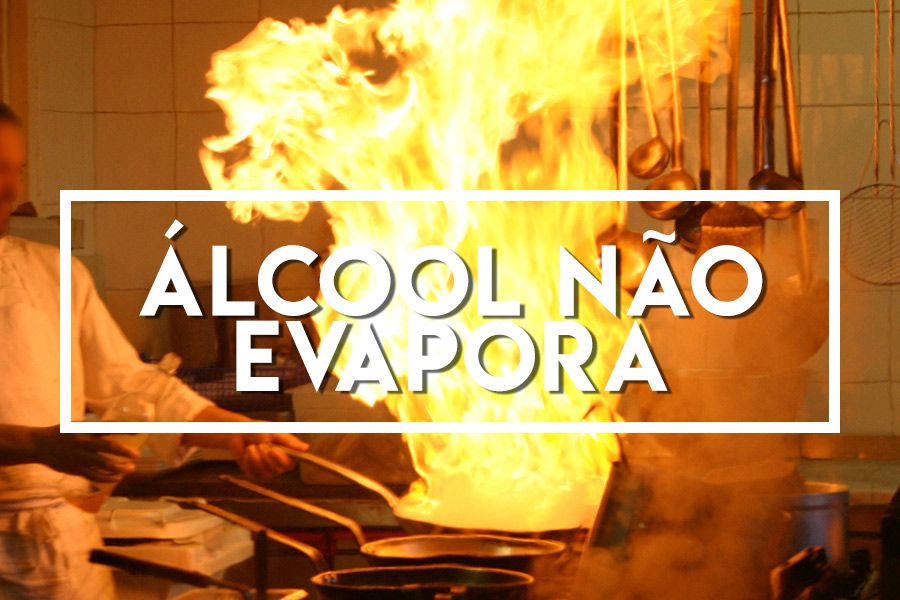One of the most common buzzwords in the kitchen that alcohol evaporates from food if you use an alcoholic drink. It is used by both amateur cooks and repeated by great chefsbut the reality is different.
The kitchen offers a range of incredible ingredients and knowing their characteristics is essential to becoming a better cook. To the alcoholic beverages They usually appear in several recipes to add that touch. In addition to the flavors and aromas, it also has the alcohol.
Who has never heard which is ok to usebecause the alcohol evaporates all during cooking. Or even worse, that burn. Is not it? Well, many people and several chefs believe this to be true, but I’m sorry to say: the information is not correct!
Does all the alcohol evaporate from the food?
Short answer: No, it won’t evaporate or burn all over.
If in your revenue it was left some liquid and it is wet: still has water e alcohol also. Like this, you must be wondering, right? Let’s go in parts!
The simplest explanation is: when you mix water e alcohol we have a special solution (a mixture) that boils below temperature normal of pure water (100°C at sea level) and pure alcohol (78.3°C at sea level).
Furthermore, the steam generated has the same proportion as the mixture of water and alcohol. The fancy (technical) name is azeotropic mixture.
In other wordsa mixture of water and alcohol to boil, both are eliminated togetherif there is liquid left both are left too.
A group of researchers from University of Idaho It’s from American Department of Agriculture (USDA: United States Department of Agriculture) tested to find out how much alcohol is left over when used in recipes.
To do this, they chose traditional french recipessuch as coq au vin (chicken in wine) and beef bourguignon (meat with wine).
The article was published in the Journal of the American Dietetic Association. In addition to being mentioned in the American Department of Agriculture (Alcohol Retention in Food Preparation). And the basis for a New York Times article.
The result was that the amount of alcohol that remains depends on the cooking method (boiled, roasted, flambéed), tempo e Type of food. But it is exhaustive: There’s always plenty of alcohol.
Among the variations, the amount of alcohol that remains:
- Alcohol added to a boiling liquid and removed from heat: 85% remains
- Ignited alcohol (flambar): 75% remains
- No heat, kept for one night: 70% remains
- Roast for 25 minutes, alcohol added without homogenizing the mixture: 45% remains
Roast-cooked over low heat (simmering)
And with the alcohol mixed, but varying the cooking time:
- 15 minutes: 40% remains
- 30 minutes: 35% remains
- 1 hour: 25% remains
- 1h30 minutes: 20% remains
- 2 hours: 10% remains
- 2h30 minutes: 5% remains
Difference between evaporating and burning alcohol
Another interesting point is the relationship between evaporate e burn: they are different processes. A burn occurs if you have partyotherwise it is evaporation. Burning is the combustion of alcohol.
As shown above, the flambar technique does not consume all alcohol. So that the alcohol catch fire it takes a minimum quantity, otherwise nothing done. That’s why it’s used brandy e liqueur of high alcohol content when flambéing.
And even when the drink generates flame, it doesn’t last forever. As the alcohol is consumed by combustion, the quantity decreases. Therefore, it is less than ideal for sustaining the flame.
Wine is a good example. Even though there is alcohol, flambéing with it is not that easy. It is necessary to heat the wine and have a flame close to the liquid and alcohol vapors. Thus, it can combust, but the flame generated will not last long.
Responsibility when using alcohol in recipes
Therefore, it is important to keep in mind that there are people who cannot drink alcohol for several reasons: alcohol dependencemedical treatment, pregnant women and the like.
A amount of alcohol can be elevated. And depending on the case, the risk of complications for the health of those who consume it exists.
It may seem like a mere detail, but anyone who works with food and can serve the most diverse types of customers is more than necessary to understand the ingredients used very well. And reduce the myths surrounding gastronomy.
Bibliography
- AUGUSTIN, J; AUGUSTIN, E; CUTRUFELLI, RL; HAGEN, SR; TEITZEL, C. Alcohol retention in food preparation. J. Am. Diet. Assoc. 1992, Apr;92(4):486-8.
- CUNNINGHAM, Eleese; MARCASON, Wendy. Does the Alcohol Used in Cooking Burn Off Completely?, Journal of the American Dietetic AssociationVolume 102, Issue 4, April 2002, Page 536, ISSN 0002-8223.
- McGEE, Harold. On food and cooking: the science an lore of the kitchen. New York: Scribner, 2004. (Portuguese | English, affiliate link)
- WOLKER, Robert L. What Einstein told his cook 1. São Paulo: Editora Zahar, 2003. (Portuguese)

Sign up for our newsletter and stay up to date with exclusive news
that can transform your routine!
Warning: Undefined array key "title" in /home/storelat/public_html/wp-content/plugins/link-whisper-premium/templates/frontend/related-posts.php on line 12
Warning: Undefined array key "title_tag" in /home/storelat/public_html/wp-content/plugins/link-whisper-premium/templates/frontend/related-posts.php on line 13




